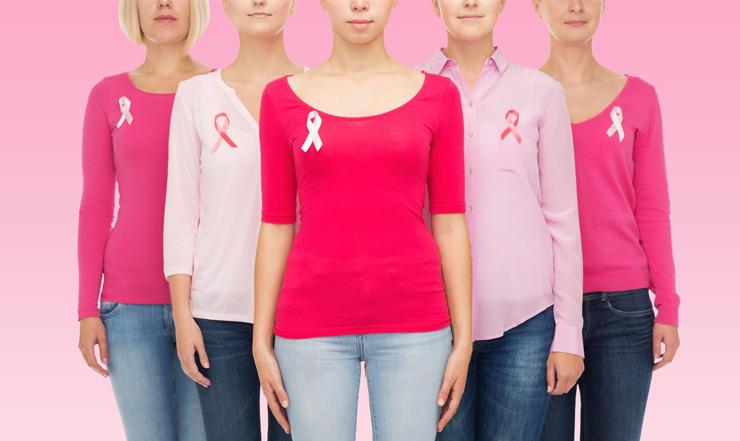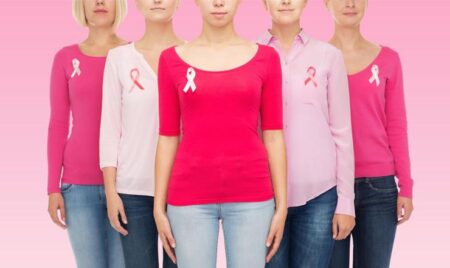
Every October, the world turns pink to honour the strength, courage, and resilience of those affected by breast cancer. But more than just a symbol of solidarity, Breast Cancer Awareness Month serves as a powerful reminder that early detection saves lives. With advancements in screening, diagnosis, and treatment, breast cancer is no longer the silent threat it once was. Yet, awareness and timely action remain our strongest allies in the fight against this disease.
Breast cancer occurs when abnormal cells grow uncontrollably in the breast tissue. While it can affect both men and women, it is far more common in women. The good news is that when detected early, breast cancer is highly treatable — with survival rates reaching over 90% in early stages. However, many cases are still diagnosed late, often because of neglecting early signs or skipping routine screenings. This is why awareness campaigns and open conversations play a crucial role: they empower individuals to take charge of their health and seek medical advice promptly.
The journey of prevention begins with awareness of one’s own body. Regular breast self-examinations can help in noticing subtle changes such as a lump, skin dimpling, nipple discharge, or persistent pain. Monthly self-checks are especially important for women over 20. At the same time, clinical breast exams and mammograms are recommended after the age of 40 or earlier for those with a family history of breast or ovarian cancer. Mammography — a simple, low-radiation screening — remains the gold standard for early detection, as it can identify tumours even before they can be felt by touch. Complementing mammograms with ultrasound or MRI scans may be advised in higher-risk individuals.
But detection alone isn’t enough; awareness must extend to lifestyle and risk management. While some factors like genetics, age, and hormonal changes are beyond our control, others can be managed through healthy habits. A balanced diet rich in fruits, vegetables, and whole grains, maintaining a healthy body weight, engaging in regular physical activity, limiting alcohol, and avoiding smoking can significantly reduce breast cancer risk. Studies have shown that even 30 minutes of daily exercise can help regulate hormones and strengthen immunity — two vital defences against cancer growth. Stress management and adequate sleep also play a quiet but powerful role in maintaining hormonal balance and overall well-being.
Equally important is breaking the silence around breast cancer. In many communities, women hesitate to discuss breast health due to stigma, fear, or lack of awareness. This delay in consultation often leads to diagnosis at more advanced stages, where treatment becomes complex. By encouraging open dialogue — whether through workplace wellness sessions, community programs, or hospital-led initiatives — we can foster a culture of prevention. Empowering women with information about screening options, symptoms, and treatment availability ensures they make timely, informed choices.
Modern medicine has made remarkable progress in breast cancer care. From minimally invasive surgeries and breast-conserving techniques to targeted therapies and personalized medicine, treatment today is far more effective and less physically taxing. Emotional support, counselling, and rehabilitation have also become integral parts of recovery, addressing not only physical healing but mental resilience. Survivors often become advocates, spreading the message that early detection isn’t just about survival — it’s about living a full, healthy life beyond the diagnosis.
As we mark World Breast Cancer Awareness Month, let’s remember that awareness is not confined to one month alone. It’s a year-round commitment to regular check-ups, mindful living, and compassionate conversations. Every reminder, every screening, and every shared story can help save a life.
Together, we can look beyond the pink ribbon — to a future where early detection is the norm, not the exception; where awareness turns into action; and where every woman feels empowered to prioritize her health without fear or hesitation.
Because when it comes to breast cancer, early detection isn’t just prevention — it’s empowerment.
Self-Breast Examination (SBE): Know Your Normal, Detect Early
When to Do It
- Once every month — ideally a few days after your menstrual period ends, when breasts are least tender or swollen.
- For post-menopausal women, choose a fixed day each month (e.g., the first Sunday of every month) to maintain consistency.
How to Perform a Self-Breast Examination (5 Simple Steps)
Look in the Mirror
- Stand straight with shoulders back and hands on your hips.
- Observe your breasts for any change in size, shape, color, or symmetry.
- Check for dimpling, puckering, redness, or nipple changes (like inversion or discharge).
Raise Your Arms and Look Again
- Lift both arms overhead.
- Look for the same visual changes or any visible swelling near the armpit area.
Check for Fluid or Discharge
- Gently squeeze each nipple to see if there’s any discharge — watery, milky, yellowish, or bloody.
- Report any unusual findings to your doctor immediately.
Feel While Lying Down
- Lie down and place a pillow under your right shoulder.
- Using the pads of your three middle fingers, move them in small circular motions over the entire breast — from collarbone to bra line and from armpit to sternum.
- Use light, medium, and firm pressure to feel tissues at different depths.
- Repeat on the left side.
Feel While Standing or in the Shower
- When skin is wet and slippery, it’s easier to feel lumps.
- Use the same circular motion to check the entire breast and armpit area.
What to Look For
- Any lump, thickening, or swelling in the breast or underarm.
- Changes in skin texture (dimpling, puckering, redness).
- Nipple changes — retraction, rash, scaling, or discharge.
- Pain or discomfort in one breast that persists beyond your menstrual cycle.
When to Seek Medical Advice
If you notice any new lump or change, don’t panic — most breast changes are not cancerous, but it’s always safest to get evaluated by a doctor. Early consultation allows for prompt testing and peace of mind.
This blog is for educational purposes only. If you notice any changes in your health, it is always wise to seek a medical expert’s consultation rather than relying solely on online information.
 Every October, the world turns pink to honour the strength, courage, and resilience of those affected by breast cancer. But more than just a symbol of solidarity, Breast Cancer Awareness Month serves as a powerful reminder that early detection saves lives. With advancements in screening, diagnosis, and treatment, breast cancer is no longer the silent threat it once was. Yet, awareness and timely action remain our strongest allies in the fight against this disease.
Breast cancer occurs when abnormal cells grow uncontrollably in the breast tissue. While it can affect both men and women, it is far more common in women. The good news is that when detected early, breast cancer is highly treatable — with survival rates reaching over 90% in early stages. However, many cases are still diagnosed late, often because of neglecting early signs or skipping routine screenings. This is why awareness campaigns and open conversations play a crucial role: they empower individuals to take charge of their health and seek medical advice promptly.
The journey of prevention begins with awareness of one’s own body. Regular breast self-examinations can help in noticing subtle changes such as a lump, skin dimpling, nipple discharge, or persistent pain. Monthly self-checks are especially important for women over 20. At the same time, clinical breast exams and mammograms are recommended after the age of 40 or earlier for those with a family history of breast or ovarian cancer. Mammography — a simple, low-radiation screening — remains the gold standard for early detection, as it can identify tumours even before they can be felt by touch. Complementing mammograms with ultrasound or MRI scans may be advised in higher-risk individuals.
But detection alone isn’t enough; awareness must extend to lifestyle and risk management. While some factors like genetics, age, and hormonal changes are beyond our control, others can be managed through healthy habits. A balanced diet rich in fruits, vegetables, and whole grains, maintaining a healthy body weight, engaging in regular physical activity, limiting alcohol, and avoiding smoking can significantly reduce breast cancer risk. Studies have shown that even 30 minutes of daily exercise can help regulate hormones and strengthen immunity — two vital defences against cancer growth. Stress management and adequate sleep also play a quiet but powerful role in maintaining hormonal balance and overall well-being.
Equally important is breaking the silence around breast cancer. In many communities, women hesitate to discuss breast health due to stigma, fear, or lack of awareness. This delay in consultation often leads to diagnosis at more advanced stages, where treatment becomes complex. By encouraging open dialogue — whether through workplace wellness sessions, community programs, or hospital-led initiatives — we can foster a culture of prevention. Empowering women with information about screening options, symptoms, and treatment availability ensures they make timely, informed choices.
Modern medicine has made remarkable progress in breast cancer care. From minimally invasive surgeries and breast-conserving techniques to targeted therapies and personalized medicine, treatment today is far more effective and less physically taxing. Emotional support, counselling, and rehabilitation have also become integral parts of recovery, addressing not only physical healing but mental resilience. Survivors often become advocates, spreading the message that early detection isn’t just about survival — it’s about living a full, healthy life beyond the diagnosis.
As we mark World Breast Cancer Awareness Month, let’s remember that awareness is not confined to one month alone. It’s a year-round commitment to regular check-ups, mindful living, and compassionate conversations. Every reminder, every screening, and every shared story can help save a life.
Together, we can look beyond the pink ribbon — to a future where early detection is the norm, not the exception; where awareness turns into action; and where every woman feels empowered to prioritize her health without fear or hesitation.
Because when it comes to breast cancer, early detection isn’t just prevention — it’s empowerment.
Self-Breast Examination (SBE): Know Your Normal, Detect Early
When to Do It
Every October, the world turns pink to honour the strength, courage, and resilience of those affected by breast cancer. But more than just a symbol of solidarity, Breast Cancer Awareness Month serves as a powerful reminder that early detection saves lives. With advancements in screening, diagnosis, and treatment, breast cancer is no longer the silent threat it once was. Yet, awareness and timely action remain our strongest allies in the fight against this disease.
Breast cancer occurs when abnormal cells grow uncontrollably in the breast tissue. While it can affect both men and women, it is far more common in women. The good news is that when detected early, breast cancer is highly treatable — with survival rates reaching over 90% in early stages. However, many cases are still diagnosed late, often because of neglecting early signs or skipping routine screenings. This is why awareness campaigns and open conversations play a crucial role: they empower individuals to take charge of their health and seek medical advice promptly.
The journey of prevention begins with awareness of one’s own body. Regular breast self-examinations can help in noticing subtle changes such as a lump, skin dimpling, nipple discharge, or persistent pain. Monthly self-checks are especially important for women over 20. At the same time, clinical breast exams and mammograms are recommended after the age of 40 or earlier for those with a family history of breast or ovarian cancer. Mammography — a simple, low-radiation screening — remains the gold standard for early detection, as it can identify tumours even before they can be felt by touch. Complementing mammograms with ultrasound or MRI scans may be advised in higher-risk individuals.
But detection alone isn’t enough; awareness must extend to lifestyle and risk management. While some factors like genetics, age, and hormonal changes are beyond our control, others can be managed through healthy habits. A balanced diet rich in fruits, vegetables, and whole grains, maintaining a healthy body weight, engaging in regular physical activity, limiting alcohol, and avoiding smoking can significantly reduce breast cancer risk. Studies have shown that even 30 minutes of daily exercise can help regulate hormones and strengthen immunity — two vital defences against cancer growth. Stress management and adequate sleep also play a quiet but powerful role in maintaining hormonal balance and overall well-being.
Equally important is breaking the silence around breast cancer. In many communities, women hesitate to discuss breast health due to stigma, fear, or lack of awareness. This delay in consultation often leads to diagnosis at more advanced stages, where treatment becomes complex. By encouraging open dialogue — whether through workplace wellness sessions, community programs, or hospital-led initiatives — we can foster a culture of prevention. Empowering women with information about screening options, symptoms, and treatment availability ensures they make timely, informed choices.
Modern medicine has made remarkable progress in breast cancer care. From minimally invasive surgeries and breast-conserving techniques to targeted therapies and personalized medicine, treatment today is far more effective and less physically taxing. Emotional support, counselling, and rehabilitation have also become integral parts of recovery, addressing not only physical healing but mental resilience. Survivors often become advocates, spreading the message that early detection isn’t just about survival — it’s about living a full, healthy life beyond the diagnosis.
As we mark World Breast Cancer Awareness Month, let’s remember that awareness is not confined to one month alone. It’s a year-round commitment to regular check-ups, mindful living, and compassionate conversations. Every reminder, every screening, and every shared story can help save a life.
Together, we can look beyond the pink ribbon — to a future where early detection is the norm, not the exception; where awareness turns into action; and where every woman feels empowered to prioritize her health without fear or hesitation.
Because when it comes to breast cancer, early detection isn’t just prevention — it’s empowerment.
Self-Breast Examination (SBE): Know Your Normal, Detect Early
When to Do It

 Gastro Sciences
Gastro Sciences Transplantation
Transplantation Critical Care / Intensive Care
Critical Care / Intensive Care Endocrinology and Diabetology
Endocrinology and Diabetology



